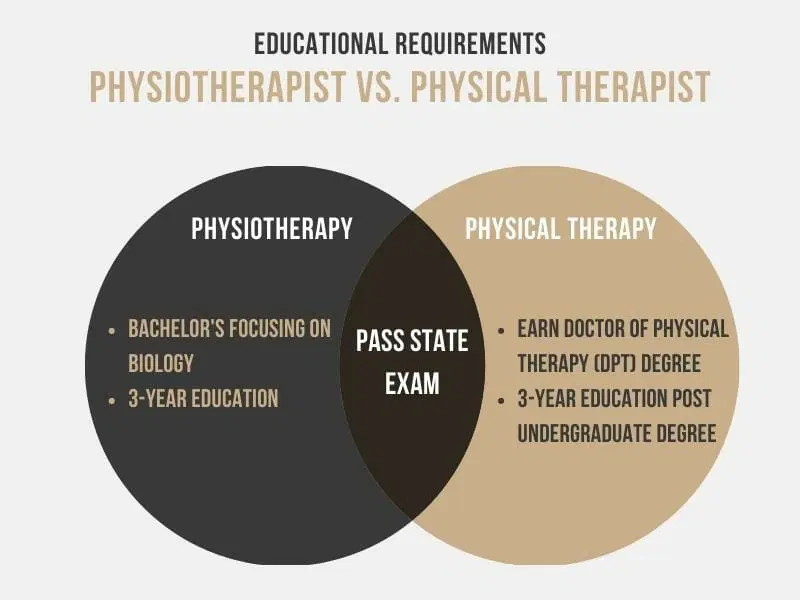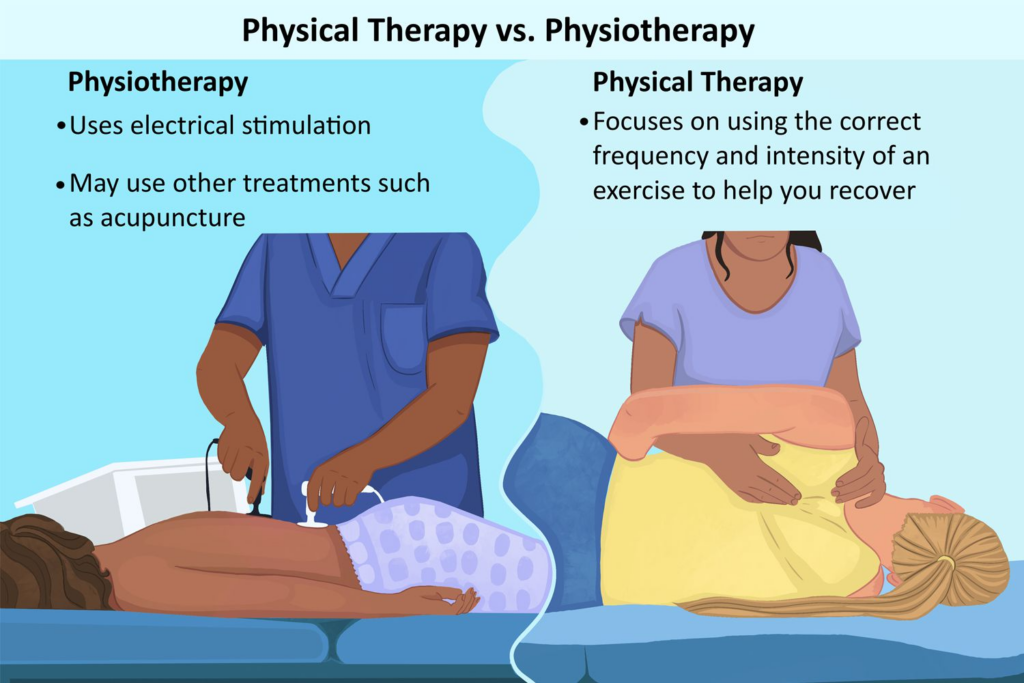
The common misuse of the terms “physical therapy” and “physiotherapy” has led to the assumption that they mean the same thing. This blog post will consider the similarities and contrasts between these two medical disciplines, their beginnings, the approaches they use, and their usage in modern medicine.
What Are The Historical Origins of Physical Therapy and Physiotherapy?
Historically physical therapy began in early 1900s America for WWI soldiers, while physiotherapy started in late 19th-century UK with massage and exercise, formalized in 1894.
The profession of physical therapy began in the early 1900s, mainly in America. Its roots can be traced back to caring for soldiers during World War I. First, physical therapy programs were set up to train ‘’reconstruction aides’’ who helped soldiers injured in combat regain function and movement.
Physiotherapy has been around for a long time, starting towards the end of the nineteenth century in the United Kingdom. It developed from nurses and midwives using massage and exercise techniques. The term physiotherapy was first used in 1894 when four nurses established the Chartered Society of Physiotherapy England.
What Are The Education and Training Required for Physical Therapy and Physiotherapy?
In terms of education in the USA, physical therapists complete a three-year DPT program and licensure exam. Internationally, physiotherapists typically earn a bachelor’s or master’s degree with varying focuses.
In the USA, physical therapists are required to complete a three-year Doctor of Physical Therapy (DPT) program after acquiring a bachelor’s degree. The curriculum entails units on anatomy, physiology, biomechanics, and clinical sciences, among other subjects. After graduation, DPT graduates must pass a national licensure examination before they can practice.
Educational requirements for physiotherapists differ across countries. In many parts of the world including the UK, Australia and Canada physiotherapists undergo a bachelor or masters program in physiotherapy. The programs cover similar subjects to physical therapy but may have slight variations in focus or duration.
What Are The Scopes of Practice of Physical Therapy and Physiotherapy?
Physical therapists in the US have the scope to handle diverse conditions and may be direct caregivers. Physiotherapists’ scope is similar but varies by country in independence and collaboration.
In the United States, physical therapists have a broad scope of practice, which includes: musculoskeletal disorders, neurological conditions, cardiopulmonary rehabilitation, pediatric, sports injuries, etc.
It is worth mentioning that physiotherapists’ scope of practice is generally similar to that of physical therapists.
Some countries allow physiotherapists more independence in prescribing medications or carrying out diagnostic tests. In some places, physical therapy puts more focus on manual treatments than others do.
Different countries might have varying degrees of interprofessional collaboration between PT and other healthcare professions.
How Does Physical Therapy Work?

Physical therapy uses techniques like exercise, manual therapy, and education to treat musculoskeletal, neurological, and other conditions, aiming to restore function and improve movement.
Physical therapy (PT) encompasses exercises as well as manual techniques aimed at enhancing mobility, function, and strength. As practitioners, they would examine the nature of a patient’s condition, after which they would develop tailor-made treatment plans focused on addressing issues like pain management or injury recovery for long-term illnesses.
Preoperative and postoperative PT may involve stretching, weight training, balance exercise, or other modalities such as ultrasound or electric stimulation during therapy sessions. Regular sessions and at-home exercises can help patients maintain overall health and prevent future injuries.
What Are The Specialties and Advanced Practice of Physical Therapy and Physiotherapy?
In the US, physical therapy offers specialized certifications in areas like orthopedics and neurology. Physiotherapy globally includes similar and additional specializations, often requiring postgraduate education and experience.
Physical therapy in the US offers specialized certifications in different areas of specialization. These include orthopedics, neurology, pediatrics, geriatrics, cardiovascular & Pulmonary Rehabilitation, etc.
These certifications require additional education, clinical experience, and passing a specialty exam.
Sometimes, physiotherapists may choose their specialization depending on country practices and rules of registration with a professional body.
Common areas of specialization may consist of musculoskeletal physical therapy, neurological rehabilitation, cardiorespiratory, etc.
Different specialization requirements exist but mostly demand postgraduate education and work-related experience.
What Is The Healthcare System Integration Process of Physical Therapy and Physiotherapy?
Physical and physiotherapy integrate into healthcare by collaborating with other professionals, following protocols for referrals, and coordinating care to address comprehensive patient needs effectively.
The integration of physical therapy/physiotherapy into healthcare systems can vary.
In some countries, these practitioners are more closely related to physicians and may frequently be found in hospitals. In America, Physical therapists usually practice in outpatient settings while having chances to directly access patients better and have more access to patients.
The role of physical therapists and physiotherapists as primary caregivers might vary based on region.
Is Physical Therapy Better Than a Gym?
Physical therapy is tailored for rehabilitation and specific conditions, while a gym focuses on general fitness. Therapy offers specialized, supervised care; a gym provides broader exercise options.
Physical therapy and gym workouts are two different things. PT is done under supervision by professionals who rehabilitate an injury, prevent further injury, and suggest exercises that target specific illnesses.
Gym workouts focus on fitness without restriction on age or gender through strength training or endurance activities alone. These two options are meant for different purposes. The choice depends on personal health goals.
Is physical therapy harder than nursing?

Comparing physical therapy and nursing is complex; both have unique challenges. Physical therapy focuses on rehabilitation, while nursing involves diverse patient care tasks and clinical responsibilities.
Both are demanding professions that are distinct in their scope of activities and responsibilities. PT entails deep understanding of musculoskeletal systems as well as neuromuscular systems. It comprises a lot of physical exercise and patient rehabilitating.
Nursing includes administering drugs to patients, checking their health changes and offering them emotional support. Both require lots of education and training, communication ability alongside empathy. However, this perceived difficulty depends on personal strengths and interests in healthcare.
What goes on during a Physical Therapy Session?
During a physical therapy session, patients receive personalized exercises, manual therapy, and education aimed at improving movement, strength, and function based on their specific condition.
During physical therapy sessions, therapists assess the condition of patients. They get an insight into the patient’s symptoms and goals. Such sessions may include procedures like hand therapies, targeted exercises done with ice and heat or electrical stimulation among others. Therapists instruct exercises for improving strength, flexibility plus mobility.
Consequently, they teach about body mechanics and injury prevention. Typically, a session concludes with summary remarks noting any improvements made within this period and providing instructions concerning home exercises. They help the patient retain gains made with the therapy.
How do insurance reimbursements work?
Insurance reimbursements cover part of medical costs based on policy terms. Patients pay upfront, then submit claims for reimbursement, which insurers process and pay directly.
Insurance compensation is not consistent for physiotherapy:
In some countries with nationalized health care systems, physical therapy might more likely be accessible through governmental insurance packages.
However, US coverage for these services differs based on the state regulations and types of plans used by insurers.
Conclusion
While there are differences in terms, educational necessities, degrees, etc based on the country these two professionals share the same aim. Both of them focus on improving patient’s mobility, functionality and overall quality of life through different therapeutic techniques. Both of these professions require rigorous training before they can start practicing on their own.
